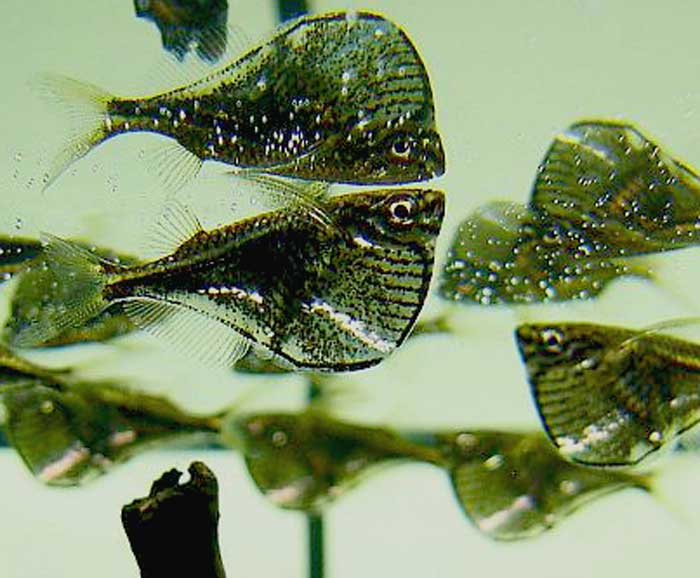
Carnegiella marthae
Superregnum : Eukaryota
Cladus: Unikonta
Cladus: Opisthokonta
Cladus: Holozoa
Regnum: Animalia
Subregnum: Eumetazoa
Cladus: Bilateria
Cladus: Nephrozoa
Superphylum: Deuterostomia
Phylum: Chordata
Subphylum: Vertebrata
Infraphylum: Gnathostomata
Megaclassis: Osteichthyes
Superclassis/Classis: Actinopterygii
Classis/Subclassis: Actinopteri
Subclassis/Infraclassis: Neopterygii
Infraclassis: Teleostei
Megacohors: Osteoglossocephalai
Supercohors: Clupeocephala
Cohors: Otomorpha
Subcohors: Ostariophysi
Sectio: Otophysa
Ordo: Characiformes
Familia: Gasteropelecidae
Genus: Carnegiella
Species: Carnegiella marthae
Name
Carnegiella marthae Myers, 1927
References
Carnegiella marthae – Taxon details on Integrated Taxonomic Information System (ITIS).
Vernacular names
English: Blackwinged hatchetfish
suomi: Kääpiötapparakala
magyar: Törpe baltahasúlazac
norsk: Øksefisk
polski: Topornica mała
português: Peixe-borboleta
中文: 黑翼飛脂鯉
The black-winged hatchetfish (Carnegiella marthae) is a freshwater ray-finned fish native to South America.[1]
George Myers named this fish after his first wife Martha.[2]
Description
Black-winged hatchetfish has a convex body. It has a very deep ventral profile with its anal fin set back. This species has wing-like pectoral fins that often extend to half of the fish's body length. In general, coloration is silver with black patches and stripes but, depending on the angle of light, colors may vary. A stripe that is usually gold stretches horizontally from the gill cover the base of the tail. Black-winged hatchetfish can reach up to 1.5 inches in length.
Distribution and habitat
Black-winged hatchetfish live in the calm streams and pools of the Orinoco and Negro region in South America.
Diet
Black-winged hatchetfish are omnivorous. They can be fed live as well as flake foods. In the wild, they feed mainly at the surface for insects, but can also eat crustaceans.
In the aquarium
Black-winged hatchetfish are peaceful fish that will do well with many other types of tropical fish such as smaller species of catfish and tetras. Make sure that there are small floating plants. Cover every hole at the top of the aquarium because in the wild, hatchetfish catch insects by jumping out of the water. Blackwinged hatchetfish inhabit the top of the aquarium.
See also
Freshwater hatchetfish
References
Aquarium Fish by Dick Mills from DK Handbooks
Christopher Scharpf & Kenneth J. Lazara (22 September 2018). "Order CHARACIFORMES: Families IGUANODECTIDAE, TRIPORTHEIDAE, BRYCONIDAE, CHALCEIDAE and GASTEROPELECIDAE". The ETYFish Project Fish Name Etymology Database. Christopher Scharpf and Kenneth J. Lazara. Retrieved 15 August 2021.
Retrieved from "http://en.wikipedia.org/"
All text is available under the terms of the GNU Free Documentation License

